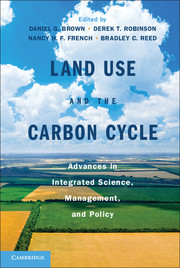Book contents
- Frontmatter
- Contents
- Chapter Authors and Affiliations
- Acknowledgments
- Acronyms
- Part I Introduction
- Part II Measurement and Modeling
- Part III Integrated Science and Research Applications
- Part IV Land Policy, Management, and the Carbon Cycle
- 13 Managing Carbon: Ecological Limits and Constraints
- 14 Effects of Wildland Fire Management on Forest Carbon Stores
- 15 Soil Carbon Dynamics in Agricultural Systems
- 16 U.S. Policies and Greenhouse Gas Mitigation in Agriculture
- 17 Opportunities and Challenges for Offsetting Greenhouse Gas Emissions with Forests
- 18 Opportunities and Challenges for Carbon Management on U.S. Public Lands
- 19 Design and Planning of Residential Landscapes to Manage the Carbon Cycle: Invention and Variation in Land Use and Land Cover
- Part V Synthesis and Future Directions
- Index
- Plate Section
- References
16 - U.S. Policies and Greenhouse Gas Mitigation in Agriculture
Published online by Cambridge University Press: 05 February 2013
- Frontmatter
- Contents
- Chapter Authors and Affiliations
- Acknowledgments
- Acronyms
- Part I Introduction
- Part II Measurement and Modeling
- Part III Integrated Science and Research Applications
- Part IV Land Policy, Management, and the Carbon Cycle
- 13 Managing Carbon: Ecological Limits and Constraints
- 14 Effects of Wildland Fire Management on Forest Carbon Stores
- 15 Soil Carbon Dynamics in Agricultural Systems
- 16 U.S. Policies and Greenhouse Gas Mitigation in Agriculture
- 17 Opportunities and Challenges for Offsetting Greenhouse Gas Emissions with Forests
- 18 Opportunities and Challenges for Carbon Management on U.S. Public Lands
- 19 Design and Planning of Residential Landscapes to Manage the Carbon Cycle: Invention and Variation in Land Use and Land Cover
- Part V Synthesis and Future Directions
- Index
- Plate Section
- References
Summary
Introduction
Fossil fuel combustion is the predominant source of greenhouse gas (GHG) emissions in the United States and consequently has been the major focus of strategies for GHG mitigation. However, current efforts to transform the energy sector from high-carbon (C) energies (i.e., fossil fuel) to no- or low-C technologies are costly and will require a long time frame for the necessary technological innovation and adoption. Several authors have touted mitigation in agriculture, forestry, and other land-use (AFOLU) change as a bridge to a low-C energy future (Lecocq and Chomitz 2001; Lee, McCarl, and Gillig 2005).
In the United States, AFOLU activities provide a partial offset against emissions from other sectors. Agriculture generates about 8 percent of total GHG emissions, of which virtually all are attributable to nitrous oxide (N2O) and methane (CH4) from crop and livestock (GHG emissions from forestry and land-use change are negligible in the United States). However, land-use change and management activities in the United States generate a sufficiently large net C sink to more than offset agricultural GHG emissions, resulting in negative net emissions for AFOLU activities. The C sink for U.S. land use and land-use change is representative of developed countries in temperate climates; however, it contrasts with the pattern in tropical developing countries where global land use and land-use change are net C sources, primarily as a result of net deforestation (Intergovernmental Panel on Climate Change [IPCC] 2007; see Chapter 3).
- Type
- Chapter
- Information
- Land Use and the Carbon CycleAdvances in Integrated Science, Management, and Policy, pp. 403 - 430Publisher: Cambridge University PressPrint publication year: 2013
References
- 2
- Cited by



